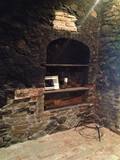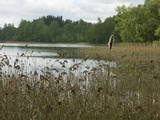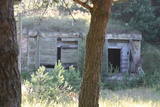| Нo | Название | Описание |
|---|---|---|
|
Народный дом расположен в здании, построенном в середине 18-го века, в котором находился трактир. Для сохранения этого более чем 135-летнего здания культурно-исторического наследия в 2011 году в нем были проведены масштабные реставрационные работы. В настоящее время в Народном доме устраиваются различные мероприятия, для посетителей открыт выставочный зал и краеведческое пространство - «Комната старинных вещей». |
||
|
В центре Вецпиебалги, со стороны дороги Берзкрогс – Мадона виден пруд, в котором выращивают разных сортов и цветов водяные лилии. Здесь можно послушать рассказ хозяина о том, как появилась столь популярная «народная песня» о водяных лилиях Вецпиебалги. Покупка растений и практические советы. Пока родители слушают истории, дети могут покормить карасей, которые едят с рук. |
||
|
Маршрут подходит для активных туристов, интересующихся многообразием природной и культурной среды национального парка «Кемери». Национальный парк «Кемери» (основан в 1997 г.) создан, прежде всего, для защиты водноболотных угодий – мелководного побережья Рижского залива, заросших прибрежных озер, болот, влажных лесов (трясин и др.) и пойменных лугов, как значимых мест произростания многих растений (~ 25 % от видов растений, занесенных в Красную книгу Латвии) и обитания животных, особенно мест скопления гнездящихся и перелетных птиц. На территории парка находится один из крупнейших заболоченных массивов Латвии – Большое Кемерское болото. Заболоченные массивы являются значимым местом образования и выхода сероводородных вод, а также местонахождения лечебных грязей, используемых в медицине, которые в свое время послужили основанием для создания известного курорта «Кемери». Информация о маршруте от Latvijas Lauku forums |
||
|
Redāns ir 19. gadsimta beigās celtā Liepājas Jūras cietokšņa daļa, kur notikušas Latvijai nozīmīgas cīņas. Lai gan uzbūvētie nocietinājumi ap Karostu tika atzīti par stratēģisku kļūdu un vairums no tiem saspridzināti, Redāns palicis teju neskarts. Tā ir arī vienīgā nocietinājuma daļa, kur notikusi reāla karadarbība.Par liecina ložu šautie caurumi sienās. 1919. gada 14. novembrī šeit notika brīvības cīņas par neatkarīgu Latviju, aizstāvot Liepāju pret Bermonta karaspēku. 14. novembra rītā, pārejot aizsalušo Tosmares ezeru, bermontiešu kājnieki ieņēma Redānu. Taču dažu stundu laikā liepājnieki veica niknu pretuzbrukumu, un vāciešiem nācās atkāpties. Jūnijā, jūlijā un augustā katru dienu plkst. 11.00–17.00 pie Redāna gaidīs zinošs gids, kas būs gatavs pastāstīt vairāk par Liepājas cietoksni un vēsturiskajiem notikumiem Karostā. Cena – 2 EUR no personas. |
||
|
Находится рядом с Музеем шоколада в Пуре. С террасы приоткрывается обширный вид на древнюю долину Абавы. Меню меняется в зависимости от сезона и спроса. Латышская кухня: Холодный суп, щавелевый суп, тушеный зеленый горошек с морковью, печень по-строгановски, десерт из овсяных хлопьев, молочный кисель с ягодным соусом. Особое блюдо: Блюда с изделиями и гарнирами „Pure Chocolate”. |
||
|
Matsalu muiža pirmoreiz vēsturiskajos avotos ir minēta 1560. g., kad tā ietilpa Lihulas bīskapijas sastāvā. Tagad redzamās ēkas ir celtas laikā no 18. gs. otrās puses līdz 20. gs. sākumam. Pagājušā gadsimta sešdesmitajos gados te plānoja izveidot Matsalu rezervāta centru, taču „veiksmīgā loze” tika netālu esošajai Penijē muižai (sk. iepriekš). Mūsdienās muižas pils, citas ēkas un parks (tajā dīķis ar salu) atrodas kritiskā stāvoklī. Taču kā nozīmīgu vēstures liecinieku arī šo muižu var iekļaut apskatāmo objektu sarakstā. Muižas komplekss atrodas pa ceļam uz Kēmu (Keemu) putnu vērošanas torni. |
||
|
Atrodas Rīgas ielā 39. Dievnams celts 1848. – 1849. g. klasicisma stilā (arhitekts A. Štauberts), bet laikā no 1924. – 1934. g. pārbūvēts (A. Vizuļa projekts). Dievnama izskatu salīdzina ar Svētā Pētera katedrāles veidolu Vatikānā. Blakus baznīcai atrodas Rīgas ielas gājējiem domātā daļa. |
||
|
В хозяйстве по старинным бабушкиным рецептам, на листьях клена пекут душистый «Кисло-сладкий кузнечный» и Кузнечный ржаной» хлеб, хрустящую корочку которого смазывают льняным маслом. Предлагается поучаствовать в процессе выпечки хлеба, дегустация и приобретение. |
||
|
Ogu un augļu dārzs, dažādu ievārījumu, sulu, sīrupu ražošana un tirdzniecība.
|
||
|
«Ильзенберг» - это первая самая крупная в странах Балтии ферма в поместье. На ферме, существующей в гармонии с природой, можно увидеть и приобрести разные сорта хлеба на натуральной закваске, домашних птиц и их яйца, мясо, молоко и молочные продукты скота, выращенного на экологически чистых пастбищах, выращенную в прудах рыбу, дары сада, охраняемого традициями, разные овощи, пчелиный мёд, собранный в максимально экологических окрестностях поместья, также разные сушеные, квашеные и копченые продукты. |
||
|
Atrodas Skuķu ezera ziemeļaustrumu krastā. No torņa labi saskatāms aizaugušais Skuķu ezers ar nelielām ūdens lāmām un ūdeņiem bagātos pavasaros pārplūstošā Dvietes paliene. Laba putnu vērošanas vieta. |
||
|
Мастерская находится в историческом здании Алсунгского музея, где вы cможете увидеть, как рождаются суйтские традиционные костюмы и их элементы, более подробно ознакомиться с ткацкими традициями Суйтского края и осмотреть богатое суйтский приданое. У каждого есть возможность самому поработать в мастерской под руководством опытных мастеров. |
||
|
Atrodas t.s. Baznīcu kalnā – 18. novembra ielā 66. Apjoma ziņā – lielākais Daugavpils luterāņu dievnams, kuru cēla laikā no 1891. - 1893. g. neogotiskā stilā no sarkanajiem ķieģeļiem (arhitekts Vilhelms Neimanis). 1941. g. baznīcā izcēlās ugunsgrēks un gāja bojā lielākā daļa no tās sākotnējās iekārtas. Turpmāko divu gadu laikā baznīcu daļēji atjaunoja, taču vēlāk tajā izveidoja noliktavu u.c. baznīcai „nepiederīgas” iestādes. 1985. g. ēka vēlreiz cieta ugunsgrēkā. Pagājušā gadsimta deviņdesmito gadu sākumā uzsāka baznīcas atjaunošanas darbus, uzstādīja solus un altāri, kas ir Ogres Amatniecības vidusskolas audzēkņu darinājums. |
||
|
В хозяйстве разводят коз и выращивают овощи. Предлагают экскурсию, участие в доении коз, дегустацию и приобретение даров села – сыра, хлеба и пирожков. Предлагается поучаствовать в приготовлении сыра. |
||
|
База отдыха «Леясмалас» находится на берегу озера Леяс с красивым видом на острова. Предлагает латгальские блюда, приготовленные из продуктов, выращенных в собственном хозяйстве. Латышская кухня: Бульбешники (и с морковью), 7 видов сыра, домашние колбасы (вареные, жареные, кровяная колбаса), секонкас (теплое блюдо из свиных внутренностей), рыбный суп, копченный угорь, фаршированная щука, рыбные котлеты, березовый сок, самогон. Особое блюдо: Аулейские клёцки. |
||
|
This park was set up to protect the lovely ancient valley of the Dubysa River. This is one of the most popular rivers for water tourism in Lithuania, because it has a significant drop with rapids and beautiful shorelines.
|
||
|
Vairākas salas Zvirgzdenes ezerā, uz kurām saglabājušies platlapju (ozolu, liepu) meži ar bagātīgu zemsedzes floru. Salas var redzēt no ceļiem, kas piekļaujas ezera ziemeļu un austrumu krastam. |
||
|
Семейный ресторан, гостиница, прокат велосипедов – в 4 км от Пиньки, в 12 минутах езды от аэропорта «Рига». Команда из 12 профессиональных поваров готовит широкий ассортимент блюд. Полное меню: facebook.com/irbenilv/menu. Также предлагаются блюда навынос. Группам больше 10 человек желательно записываться заранее. |
||
|
Во времена Советского Союза задачей 77-й армейской зенитноракетной бригады была противовоздушная оборона внешних границ союза. В настоящее время объект принадлежит самоуправлению края, заброшен, не охраняется и не используется. У главного входа на ракетную базу сохранились интересные ворота.
|
||
|
Biškopības produktu ražošana - medus, ziedputekšņi, bišu maize, propoliss, bišu māšu peru pieniņš. Bišu māšu selekcija, bišu saimes. |
||

























